it用法归纳
英语语法:高中英语It的用法

【导语】"It"⽤法及其句型和固定搭配,是⾼中英语语法的重点、难点,⼜是近⼏年⾼考的热点,因此应给予充分的重视,⽆忧考整理了“it的⽤法”,欢迎阅读参考!更多相关讯息请关注⽆忧考!⼀、It⽤作实词表达以下概念:指代前⽂提到的事物,如前⽂中的this, that;替代前⽂中的内容;指代⼀位性别不明的⼩孩或未知的⼈;指代未指明但谈话双⽅都知道的那件事;指代时间、天⽓、⽓候、距离等⾃然现象……⼆、It⽤作形式主语替代作主语的从句、动词不定式、动名词,⽽把真正作主语的从句、动词不定式、动名词置于句尾。
It 作形式主语的常见句型:1. 代作主语的动词不定式,其句型为:(1) It be adj. (for sb.) to do sth.此处adj. 通常为描述事件的形容词:easy, difficult, hard, necessary, unnecessary, possible, impossible, likely, unlikely, right, wrong, important, unimportant, legal, illegal, well-mannered, ill-mannered, polite, impolite, clear, obvious, certain, suitable, proper, fit, useful, useless, dangerous…例: It is illegal (for a teenager) to drive a car without a license.(2) It be adj. of sb. to do sth.此处adj. 通常为描述⼈的形容词:kind, unkind, nice, rude, cruel, considerate, thoughtful, thoughtless, careful, careless, silly, foolish, stupid, clever, wise, crazy.例: It's kind of you to help me with the problem.(3) It替代作主语的动名词的常见句型:It's no good/use doing…It's (well)worth doing…It's (well)worth one's while doing/to do…It's (well)worth while doing/ to do例: It's no use crying over spilt milk(覆⽔难收).2. It替代作主语的从句常见句型:(1) It is + noun +从句例: It is no secret that the president wants to have a second term at office.(2) It is adj. +clauseIt's surprising that… (should)………竟然……It's a pity/shame that…(should)………竟然……例: It's important that you should apologize to her for your rudeness.(=It's of much importance that you should apologize to her for your rudeness.)(3) It verb sb. + clause= It is v-ing + clauseIt+surprise/delight/interest/disappoint/worry/disturb/annoy/amaze /bother/concern/frighten/please/anger sb. that…例: It worried me that she drove so fast.(= It was worrying that she drove so fast.)(4) It verb (to sb.) that…= sb/sth verb to do例: It (so) happened/chanced that they were out.(= They happened/chanced to be out.)(5) It is v-ed that…=sb/sth is to do(verb=say, report, think, believe, hope, expect, agree, accept, decide, determine, intend, plan, understand, know)例: It is said that the couple have gotten divorced.(=The couple are said to have gotten divorced.)(6) It is v-ed that … (should)…(verb=demand, request, require, order, suggest, advise, recommend例 It is suggested that they should begin with the third question.三、It作主语的句型1. It takes sb. … to do…(=sb takes…to do…)某⼈⽤多长时间做某事例: It took the men a week to mend our roof.(= The men took a week to mend our roof.)2. It's (just)(un)like sb. to do…(不)像某⼈做某事的风格例: It was (just) like him to think of helping us.3. It's (about/high) time that… should /v-ed…是该做某事的时候了例: It's(about/high) time that we should take action.4. It's the x-th time (that) … have v-ed…第⼏次做某事了例: It's the third time that he has failed the driving test.5. It is/has been… since …continuous v-ed(延续性动词) 某动作持续了多长时间例: It's 10 years since he lived here6. It was(not)… before…过(不)了多长时间某动作发⽣了例: It was not long before they arrived.四、It 作形式宾语⽤来替代作宾语的从句、动词不定式、动名词,⽽把真正作宾语的从句、动词不定式、动名词置于句尾。
it的用法归纳

it的用法归纳
1. 代词:it可以代替前面出现过的事物、物品、动物等,做主语、
宾语、表语等。
例句:I saw a bird in the tree. It was singing beautifully. (我看见了一只鸟在树上。
它唱得很美。
)。
2. 指示代词:it也可以作为指示代词,用来指代某一事物或物品。
例句:I want this book, not that one. Give me it.(我想要这
本书,不是那本。
给我它。
)。
3. 不定式:it可以作为不定式的形式,表示“它”的含义,一般表
示时间、天气等。
例句:It’s nice to see you again.(很高兴再次见到你。
)。
4. 表示真理或存在:it可以用来表示某件事或事物的存在或真相。
5. 表示强调:it可以作为强调句的主语,强调句子中重要的信息。
例句:It was him who broke the vase, not me.(是他打破了花瓶,不是我。
)。
6. 虚主语:it可以作为虚主语出现在句首,表示无人称、无性别的
动作或状态。
(完整版)It的用法总结

It的用法总结在英语中,it有许多不同的用法,它既可以用作代词(如人称代词、非人称代词),也可以用作引导词(作形式主语或形式宾语),还可以用来构成强调句型。
.it用作代词(1) 用作人称代词在句子中作主语或宾语;指前面已经提到过的事物、动物或人,且it指特定的事物;如果指前文中提到的事物中的任何一个,用one。
one可以与any, each, every, not等连用,但one不可代替不可数名词。
—where’s your car?—it’s in the garage. 你的汽车在哪儿呢?在车库里。
(指代物品your car)did you hit it? 你打中了吗? (指代事件)the baby cried when it was hungry.这婴儿饿时就哭。
(指代婴儿,尤指性别不详或无所谓时)—who is that?—it’s me. 是谁?我。
(指一定情景中所确定的人或事物,此时相当于指示代词,代指this和that,有时也指人)—what’s this?—it’s a box. 这是什么?一只箱子。
(2) 作非人称代词表示天气、日期、时间、温度、距离、价值、路程、度量、自然现象与环境等。
也可模糊地指一般情形或上文的部分或整个意思。
译成汉语时,it通常不一定译出来。
it’s a long time since they left. 他们走后很久了。
it’s two miles to the beach.离海滨有两英里远。
that’s just it—i can’t work when you’re making so much noise.原因就在这里——你弄出这么大的声音,我工作不了。
另外,需要注意两点:(1)“it’s time…”后面可以接不定式和介词短语表示“是做……的时候了”。
如:it’s time for supper. it’s time to have supper.(2) “it’s time…”后面还可以接一个从句,但是从句中的谓语动词一定要用过去式即虚拟语气,如:it’s time we had lunch.是我们吃饭的时候了。
超详细的It的用法归纳总结(附习题及答案)!
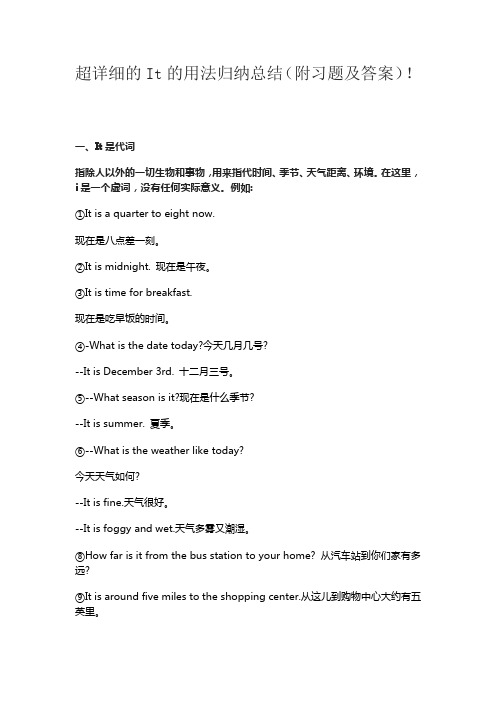
超详细的It的用法归纳总结(附习题及答案)!
一、It是代词
指除人以外的一切生物和事物,用来指代时间、季节、天气距离、环境。
在这里,i是一个虚词,没有任何实际意义。
例如:
①It is a quarter to eight now.
现在是八点差一刻。
②It is midnight. 现在是午夜。
③It is time for breakfast.
现在是吃早饭的时间。
④-What is the date today?今天几月几号?
--It is December 3rd. 十二月三号。
⑤--What season is it?现在是什么季节?
--It is summer. 夏季。
⑥--What is the weather like today?
今天天气如何?
--It is fine.天气很好。
--It is foggy and wet.天气多雾又潮湿。
⑧How far is it from the bus station to your home? 从汽车站到你们家有多远?
⑨It is around five miles to the shopping center.从这儿到购物中心大约有五英里。
it的七种用法
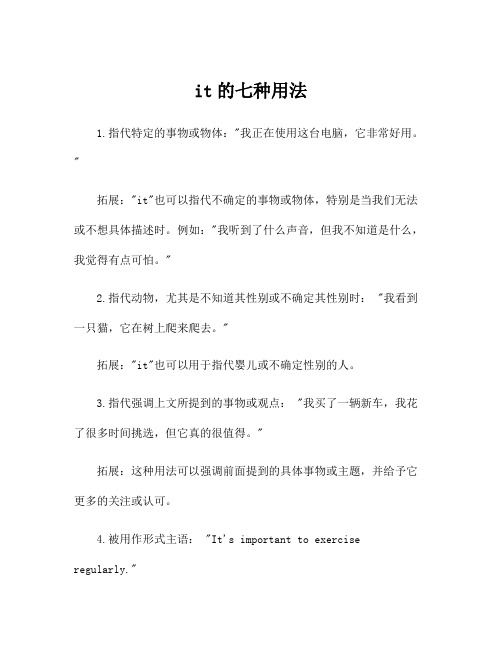
it的七种用法1.指代特定的事物或物体:"我正在使用这台电脑,它非常好用。
"拓展:"it"也可以指代不确定的事物或物体,特别是当我们无法或不想具体描述时。
例如:"我听到了什么声音,但我不知道是什么,我觉得有点可怕。
"2.指代动物,尤其是不知道其性别或不确定其性别时: "我看到一只猫,它在树上爬来爬去。
"拓展:"it"也可以用于指代婴儿或不确定性别的人。
3.指代强调上文所提到的事物或观点: "我买了一辆新车,我花了很多时间挑选,但它真的很值得。
"拓展:这种用法可以强调前面提到的具体事物或主题,并给予它更多的关注或认可。
4.被用作形式主语: "It's important to exercise regularly."拓展:在某些句子中,"it"可以用作形式主语,代表主语部分的内容,尤其是当真正的主语是以后出现时。
5.引导强调句: "It was John who broke the vase."拓展:在强调句中,"it"被用作形式主语,而真正的主语将被放置在句子的后部,以便强调。
6.用于指示时间、天气和环境条件: "It's raining outside."拓展:"it"在描述天气、时间或条件时,常用于英语中,例如:"It's getting late." "It's hot today."7.在某些习语中,表示状态或情感: "I'm over it." (我已经度过了这个困境)拓展:在某些习语或俚语中,"it"用于表示情感、状态或体验,并在一定程度上代表所描述的特定情况。
(完整版)It的用法总结
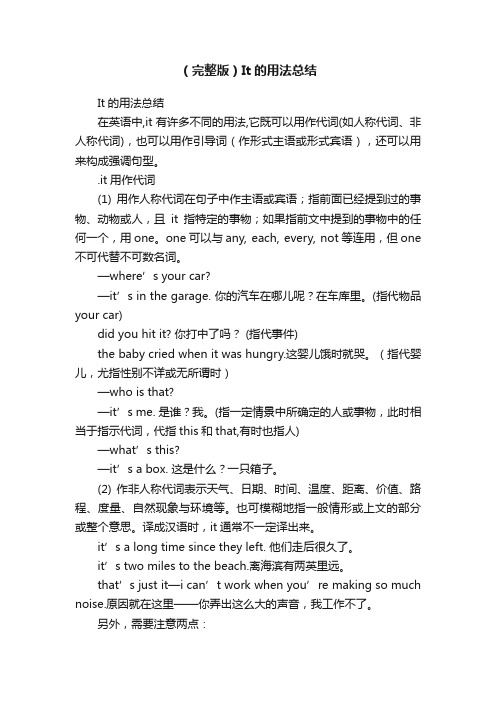
(完整版)It的用法总结It的用法总结在英语中,it有许多不同的用法,它既可以用作代词(如人称代词、非人称代词),也可以用作引导词(作形式主语或形式宾语),还可以用来构成强调句型。
.it用作代词(1) 用作人称代词在句子中作主语或宾语;指前面已经提到过的事物、动物或人,且it指特定的事物;如果指前文中提到的事物中的任何一个,用one。
one可以与any, each, every, not等连用,但one 不可代替不可数名词。
—where’s your car?—it’s in the garage. 你的汽车在哪儿呢?在车库里。
(指代物品your car)did you hit it? 你打中了吗? (指代事件)the baby cried when it was hungry.这婴儿饿时就哭。
(指代婴儿,尤指性别不详或无所谓时)—who is that?—it’s me. 是谁?我。
(指一定情景中所确定的人或事物,此时相当于指示代词,代指this和that,有时也指人)—what’s this?—it’s a box. 这是什么?一只箱子。
(2) 作非人称代词表示天气、日期、时间、温度、距离、价值、路程、度量、自然现象与环境等。
也可模糊地指一般情形或上文的部分或整个意思。
译成汉语时,it通常不一定译出来。
it’s a long time since they left. 他们走后很久了。
it’s two miles to the beach.离海滨有两英里远。
that’s just it—i can’t work when you’re making so much noise.原因就在这里——你弄出这么大的声音,我工作不了。
另外,需要注意两点:(1)“it’s time…”后面可以接不定式和介词短语表示“是做……的时候了”。
如:it’s time for supper. it’s time to have supper.(2) “it’s time…”后面还可以接一个从句,但是从句中的谓语动词一定要用过去式即虚拟语气,如:it’s time we had lunch.是我们吃饭的时候了。
“it”用法总结

3). It is necessary ( for sb. ) to do sth. 常见的形容词有:① important, necessary, natural ② easy , safe ,common ,normal ,hard , difficult ,dangerous , 等。 在①中的形容词作表语可以用从句改写, 如: It is important for her to come to the party. = It is important that she (should ) come to the party.
③被强调部分为人时,可用who(主格或宾格)和 whom(宾格)代替that,用that也行。 1) It was your father that/whom /who I met in the street yesterday. 2) It was I that/who met your father in the street yesterday.
3.2.作形式主语替代不定式
1). It takes sb. ... to do sth. "做...要花费某人.." It took thousands of people many years to build the Great Wall.
2). It is kind ( of sb. ) to do sth. 主句中的形容词必须是能表示逻辑主语特征的形容词。 常见的有: bad , brave , careless, clever , cruel , foolish ,stupid , wise wrong等。 这个句型可以改写为:sb. is kind to do sth. 。 It is kind of you to say so. = You are kind to say so.
“It” 重点用法归纳
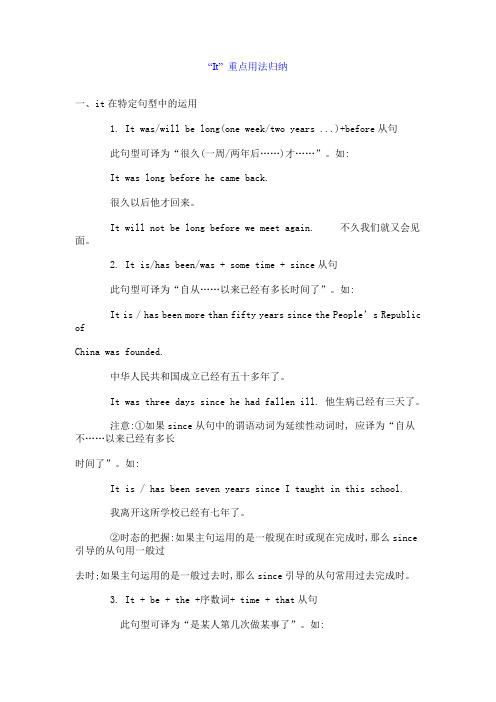
“It” 重点用法归纳一、it在特定句型中的运用1. It was/will be long(one week/two years ...)+before从句此句型可译为“很久(一周/两年后……)才……”。
如:It was long before he came back.很久以后他才回来。
It will not be long before we meet again. 不久我们就又会见面。
2. It is/has been/was + some time + since从句此句型可译为“自从……以来已经有多长时间了”。
如:It is / has been more than fifty years since the People’s Republic ofChina was founded.中华人民共和国成立已经有五十多年了。
It was three days since he had fallen ill. 他生病已经有三天了。
注意:①如果since从句中的谓语动词为延续性动词时, 应译为“自从不……以来已经有多长时间了”。
如:It is / has been seven years since I taught in this school.我离开这所学校已经有七年了。
②时态的把握:如果主句运用的是一般现在时或现在完成时,那么since 引导的从句用一般过去时;如果主句运用的是一般过去时,那么since引导的从句常用过去完成时。
3. It + be + the +序数词+ time + that从句此句型可译为“是某人第几次做某事了”。
如:It is the first time that I’ve spoken in public.这是我第一次公开发言。
注意:如果主句是一般现在时或一般将来时,从句用现在完成时;如果主句是一般过去时,从句用过去完成时。
4. It +be +具体时间+ when ...此句型可译为“当某事发生时,时间是在……”。
it的用法
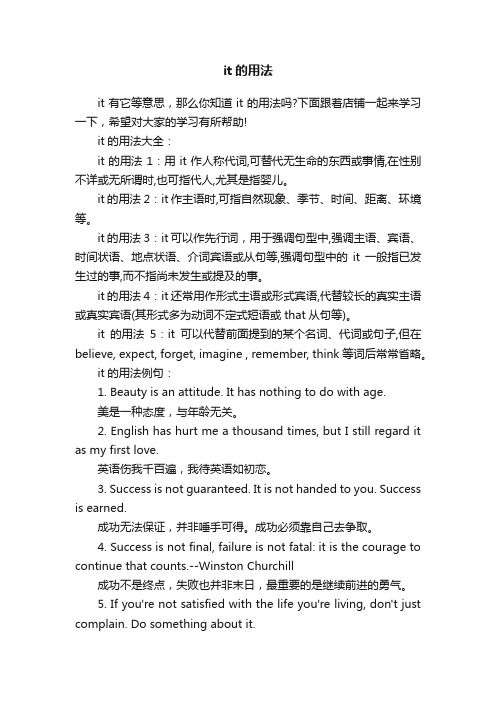
it的用法it有它等意思,那么你知道it的用法吗?下面跟着店铺一起来学习一下,希望对大家的学习有所帮助!it的用法大全:it的用法1:用it作人称代词,可替代无生命的东西或事情,在性别不详或无所谓时,也可指代人,尤其是指婴儿。
it的用法2:it作主语时,可指自然现象、季节、时间、距离、环境等。
it的用法3:it可以作先行词,用于强调句型中,强调主语、宾语、时间状语、地点状语、介词宾语或从句等,强调句型中的it一般指已发生过的事,而不指尚未发生或提及的事。
it的用法4:it还常用作形式主语或形式宾语,代替较长的真实主语或真实宾语(其形式多为动词不定式短语或that从句等)。
it的用法5:it可以代替前面提到的某个名词、代词或句子,但在believe, expect, forget, imagine , remember, think等词后常常省略。
it的用法例句:1. Beauty is an attitude. It has nothing to do with age.美是一种态度,与年龄无关。
2. English has hurt me a thousand times, but I still regard it as my first love.英语伤我千百遍,我待英语如初恋。
3. Success is not guaranteed. It is not handed to you. Success is earned.成功无法保证,并非唾手可得。
成功必须靠自己去争取。
4. Success is not final, failure is not fatal: it is the courage to continue that counts.--Winston Churchill成功不是终点,失败也并非末日,最重要的是继续前进的勇气。
5. If you're not satisfied with the life you're living, don't just complain. Do something about it.对于现况的不满,不能只是抱怨,要有勇气作出改变。
it的用法

it的用法it的用法:1、it作形式主语It is known to us that… 众所周知…… It is said that… 据说…… Itseems/appears that… 似乎/看起来…… It happened that… 碰巧……2、it作形式宾语 We consider it necessary to do sth. 我们认为有必要做某事 I find it difficult to answer the question. 我发现回答这个问题很难 He made it clear that… 他清楚地表明……3、it作形式定语 The book, which I bought yesterday, is interesting. 我昨天买的那本书很有趣The man who came just now is my teacher. 刚才来的那个人是我的老师4、it作宾语补足语 She looks pale, as if it were a disease. 她看起来苍白,好像生病了5、it作引导词It was not until then that … 直到那时才…… It is because of this that… 正因为如此才…… It is in this way that… 就是这样……6、it作状语It being Sunday, he didn’t go to work. 既然是星期日,他就不去上班了7、it作指代词 Everyone wants to have a good time, and it is true for me too. 每个人都想过的愉快的时光,对我来说也是一样。
8、it作副词 I worked harder than ever before, and it paid off. 我比以往更加努力,结果收获满满。
9、it作指示代词 Bring it here and put it on the table. 把它拿过来放在桌子上。
It用法完全归纳

it用法完全归纳一、it 作人称代词的用法1. 指事物作为人称代词,it 可以除人以外的一切事物或动物。
如:I dropped my watch and it broke.It’s hard work, but I enjoy it.“Where is the dog?” “It’s in the bedroom.”2. 指人it 指人主要用于指不性别不明的婴儿或用于确认某人的身份。
如:Is it a boy or a girl? There is a knock on the door. It must be the postman.【说明】在答语中,常用来指本人,如说It’s me。
3. 代替某些代词代词it 还可用于代替指示代词this, that 以及复合不定代词something, anything, nothing等。
如:“What’s this?” “It’s a new machine.”Nothing is wrong, is it?二、it 作非人称代词的基本用法it 作非人称代词的用法,主要用于指时间、距离、价值、天气、气候及温度等自然现象。
如:现在去那儿已经太迟了。
It’s too late to go there now.昨天下了一天的雨。
It rained all day yesterday.这里有时会很热。
It can get very hot here.三、it用作形式主语1. 基本用法It’s very important to remember this.It’s hard work climbing mountains.It’s unknown when he will come.2. It + be + adj. for (of) sb to do sth 某人做某事……他很难下定决心。
It is hard for him to make up his mind.她说那样的话,真是太蠢了。
It 的 13 个常用句型及其运用!书面表达必备!

It 的13 个常用句型及其运用!书面表达必备!It 的13 个常用句型及其运用it 虽然并不显眼,但只要运用得当,也能在书面表达中发挥出巨大的作用,给人以高大上的感觉。
本文在归纳其常用的句式结构的基础上着眼于在书面表达中如何恰当地运用it 的相关句型,以达到优化句子,增加文章亮点。
01一、it 句型的归纳:( 一) it 作形式主语的 6 个句型句型1. It is + adj. (=of n.) + for sb. to do sth. / that... 某人做某事是……的。
Will it be convenient for you to start work tomorrow? 你明天开始工作方便吗?It is vital /of great significance for students to take regular exercise. = It is vital /of great significance that students should take regular exercise. 定期进行锻炼这对学生来说太重要了。
句型2. It is a shame / pity that... 很遗憾……(1) It is a shame that some students should scribble and litterrandomly on the campus. 一些学生竟然在校园中乱涂乱画,乱扔垃圾,这真是太不应该了。
(2) It is a pity that I cannot go to see the movie on Saturday evening. 很遗憾,周六晚上我没办法陪您去看电影了。
说明: that 引导的从句为主语从句,从句中谓语动词的语气分两种情况:①表述的内容是事实,用陈述语气 , 如例句 (2) ;②若内容表明说话人的一种语气 / 情感则使用虚拟语气 , 如例句 (1) 。
it的用法总结经典句型
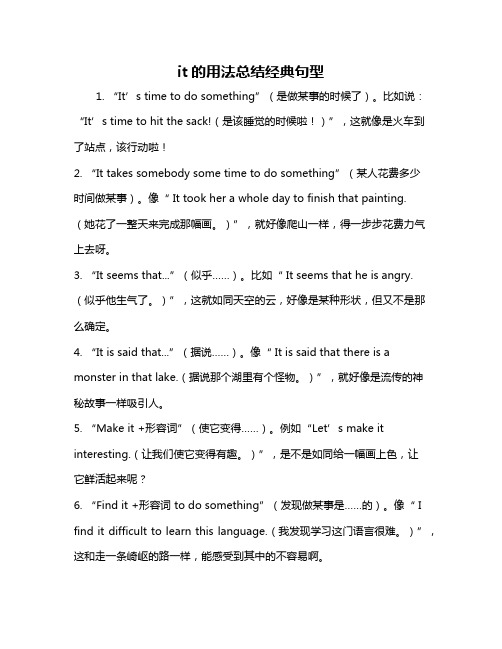
it的用法总结经典句型1. “It’s time to do something”(是做某事的时候了)。
比如说:“It’s time to hit the sack!(是该睡觉的时候啦!)”,这就像是火车到了站点,该行动啦!2. “It takes somebody some time to do something”(某人花费多少时间做某事)。
像“ It took her a whole day to finish that painting.(她花了一整天来完成那幅画。
)”,就好像爬山一样,得一步步花费力气上去呀。
3. “It seems that...”(似乎……)。
比如“ It seems that he is angry.(似乎他生气了。
)”,这就如同天空的云,好像是某种形状,但又不是那么确定。
4. “It is said that...”(据说……)。
像“ It is said that there is a monster in that lake.(据说那个湖里有个怪物。
)”,就好像是流传的神秘故事一样吸引人。
5. “Make it +形容词”(使它变得……)。
例如“Let’s make it interesting.(让我们使它变得有趣。
)”,是不是如同给一幅画上色,让它鲜活起来呢?6. “Find it +形容词to do something”(发现做某事是……的)。
像“ I find it difficult to learn this language.(我发现学习这门语言很难。
)”,这和走一条崎岖的路一样,能感受到其中的不容易啊。
我的观点结论:掌握这些关于 it 的经典句型就如同拥有了一把钥匙,可以打开英语表达的各种奇妙之门,让我们在英语的世界里更加自如地交流和表达呀!。
It的用法(超全)

---------------------------------------------------------------最新资料推荐------------------------------------------------------It的用法(超全)用法及其句型和固定搭配,是英语语法的重点、难点,又是近几年考试的热点,因此在复习中应给予足够的重视。
句型归纳:1. It is +adj.(+for sb./sth.) + to do sth.用于此句型的形容词有:easy, hard, difficult,possible, important, impossible,necessary, good, bad, exciting, interesting, surprising 等。
如:It is necessary to change your job. It was very hard for them to walk such a long way in the snow. 2.It is +n.(+for sb./sth.) + to do sth.用于此句型的名词有:pity, shame, pleasure, ones duty, ones job, fun, joy, good manners, bad manners 等。
如:It is a pity for you to have missed such a wonderful play. It is bad manners for the young to take up the seats for the old. 3.It is +adj.+of sb.+to do sth.此句型中的形容词主要描述某人的品德、特征。
能用于该句型的形容词有:1 / 13kind, nice, wise, silly, polite, impolite, friendly, foolish, clever 等。
英语中it的用法

it 在英语中的意思较多,用法较广,现总结如下;一、it作句子的真正主语1.it 指前面已经提到过的人或事物,有时指心目中的或成为问题的人或事物,作真正主语;例如:What’s this -It is a sheep这是什么这是一只绵羊;Who is it -It’s me I. 谁是我;It’s the wind shaking the window. 是风刮得窗户响;2.it指时间、季节;一般用在无人称动词的主语;例如:What time is it -It’s nine. 几点了九点了;It’s time for the meeting. Let’s go. 开会的时间到了,我们走吧;What day is today -It’s Saturday. 今天星期几今天星期六;What’s the date today -It is October 1st.今天是几号今天是十月一日;What season is it -It is summer. 现在是什么季节是夏季;3.it 指气候;一般作无人称动词的主语;例如:Is it cold in this room -No, it isn’t. 屋里冷吗不冷;What’s the weather like today -It is fine.今天天气怎么样是晴天;It often rains in summer and it often snows in winter in this city.这个城市夏天经常下雨,冬天经常下雪;4.it指距离、情况等;一般用作无人称动词的主语;例如:It is five kilometers from my home to the school.从我家到学校有五公里;It is very near from this factory to that one.从这个工厂到那个工厂非常近;It is a long way to the sea. 离海很远;Is it well with you 你身体好吗二、it作形式主语动词不定式、动名词短语起、从句在句子中起主语作用,而这一部分用词较多时,可以用it作为形式主语,放在句首代表其后所说的事实上的、真正的主语,而把真正的主语放在后面;1.It +谓语+动词不定式;It 作形式主语,动词不定式作真正的主语;例如:It is difficult to climb a mountain. 爬山是很艰难的;It’s a good habit to do morning exercises. 作早操是个好习惯;It’s important to do proper memory work in the study of a foreign language. 在学习外语时适当地做一些有助于记忆的练习是很重要的;It is right to do so. 这样做是对的;2.It+谓语+动名词短语;It 作形式主语,动名词短语作真正的主语;例如:It is dangerous playing with fire. 玩火是危险的;It is no use learning without thinking. 学而不思则罔;It’s useless arguing with a silly boy. 和笨孩子争论是没有用的;3.It +谓语+名词性从句;It 作形式主语,以that 引导的名词性从句是真正的主语;例如:It is a pity that you didn’t see such a good film.你没看这么好的电影,真可惜;It is certain that we shall succeed. 我们一定会成功;It is strange that nobody knows where he lives.真奇怪,谁也不知道他住在哪里;It is strange that…后面可用虚拟语气;如:It is strange that he should have made such a mistake.他居然犯了这样一个错误,真奇怪;It is strange that nobody should know where he lives.居然没有人知道他住在哪里,真奇怪;It is said that the plane will take off at ten tomorrow morning.据说飞机明天上午十点起飞;三、it作形式宾语it 作形式宾语,代表其后所说的真正的宾语;真正的宾语是以that 引导的名词性从句或不定式短语;例如:I consider it wrong that you Chinese students learn English without comparing it with your own language.我认为你们中国学生学习英语,不和你们自己的语言比较是不对的;I find it not so difficult to learn a foreign language.我发现学习一门外语不那么困难;I remember I made it clear to you that I was not coming.我记得向你明确表示过我不来;They want to make it clear to the public that they are doing an important and necessary job.他们要向公众表明,他们在做一件重要而又必要的工作;四、it 用于强调结构在表示强调的结构中,it 可用作先行代词,这种结构的句型如下:It +is/was +被强调的部分+that +其他部分;如果强调的部分是人,可用who, whom 代替that.例如:Professor Wang teaches us English every Monday afternoon.王教授每星期一下午教我们英语;强调主语:It is Professor Wang who teaches us English every Monday afternoon.强调间接宾语:It is us whom Prof. Wang teaches English every Monday afternoon. 强调直接宾语:It is English that Prof. Wang teaches us every Monday afternoon.强调状语:It is every Monday afternoon that Prof. Wang teaches us English.It was here that I first met him. 这就是我初次与他见面的地方;强调状语It is the people who are realy powerful.翻译练习1该上课了,快;It is time for class. Hurry up.2从这儿到你们学校远吗不远,大约一公里;Is it far from here to your school No, it isn’t. It’s about a kilometer.3从我家到颐和园去很近;It is very near from my home to the Summer Palace.4天正在下雨;It’s raining now.5电灯是爱迪生发明的;It was Edison who invented the electric light.6我认为学习一门外语是很重要的;I think it important to learn a foreign language.7他通常一天读两次英语;He made it a rule to read English twice a day.8从我家去天安门广场坐公共汽车大约要一个小时;It takes about an hour to go from my home to the Tian’anmen Square by bus.反意疑问句反意疑问句相当于“对不对”“好不好”“行不行”,用yes或 no 回答;由两部分组成,前一部分是陈述句,后一部分是附加疑问短语,中间用逗号隔开,所以反意疑问句又叫附加疑问句;通常的形式是:肯定的陈述句+否定的附加疑问,或否定的陈述句+肯定的附加疑问;如:He studies English, doesn’t heHe doesn’t study English, does heThey are from America, aren’t theyThey are not from America, are they反意疑问句的主要形式:1.如果主句是be或其他助动词如can, shall, will 等,其反意疑问句用同一助动词; 如:We are late, aren’t weYou haven’t met my wife, have youHe can drive a car, can’t heThey used to have difficulty in just making ends meet, didn’t usedn’t theyYou’d better eat with knives and forks, hadn’t you2.如果主语带有seldom, hardly, never, rarely, few, little等否定词或半否定词时,因为主句本身具有否定意义,附加疑问部分的动词用肯定式,如:We seldom go to the cinema, do weSue almost never worked, did she3.如果主句部分是“I am…”结构,由于”am not” 没有相应的缩略形式,附加疑问部分一般用aren’t I 代替;如:I am your friend, aren’t II’m late, aren’t II am a student, aren’t I在祈使句中的附加疑问部分一般用will you, won’t you.4. 在祈使句中的附加疑问部分一般用will you, won’t you.如:Sit down, will youHave some tea, won’t youOpen the window, won’t you这种句子可以理解为: Will you do something如:Will you open the window注意:否定的祈使句之后,只能用will.Don’t forget, will youDon’t make so much noise, will you5.以Let’s… 开头的祈使句,肯定的用shall we否定的用all right或OK,如:Let’s go back to our seats, shall weLet’s not have hot food this t ime, OK all right这种句子可以理解为:Shall we do something,如:Shall we go back to our seats.这样有助于理解和记忆;注意:Let’s 与Let us 的区别:Let’s包括听话人在内,应用shall we, 而Let us 不包括听话人在内,表示“请你让我们…”,要用will you.如:Let’s watch the news on TV, shall we 表示建议Let us watch the news on TV, will you 表示请求6.主句是I suppose, I think, I believe等时,附加疑问部分则往往与that 从句中的主语和谓语动词保持对应关系,但要注意否定的转移;如:I suppose that you know the meaning of the word, don’t you这句话明显是要问“你是不是知道”而不是问“我是不是这样认为”I don’t think that you have read the book, have you7.当主句的动词have 表示“拥有”时,附加疑问既可用have, 也可用do,如:You have a color TV set, haven’t you/don’t you当主句的have不表示“拥有”而表示其他意思时,附加疑问要用do,如:You had a cold yesterday, didn’t youThey don’t have coffee with breakfast, do theybe句型的反意疑问句,用there 作主语;如:There is something wrong, isn’t thereThere won’t be any trouble, will there 不会有任何麻烦,是吗9.陈述部分的主语是everyone, someone, anyone, no one, nobody等不定代词时,其疑问部分的主语可用he, 也可用they.Everyone knows it, doesn’t he/don’t they英语反意疑问句的回答有点和汉语的相反;但一定要记住:只要回答是肯定的,都用yes,只要回答是否定的,都用no;这在主句是否定句的时候要特别注意;例如:Mr. Jones can’t speak French, can he No, he can’t.琼斯先生不会讲法语,对吗对,他不会讲法语;Mr. Jones can’t speak French, can he Yes, he can.琼斯先生不会讲法语,对吗不,他会讲法语;This is not a door, is it -Yes, it is. It is an iron door.这不是门,对吗不,这是门;是扇铁门;。
It的用法

It的用法:1.it代替无生命的物体或代替动物2.句中出现了baby,无论男女,人称代词一律用it3.在电话用语、敲门用语、对话中,若双方都知道对方是谁,无论男女,人称代词用it4.指时间、季节,人称代词用it5.指距离时用于:How far is it from + 地点+ to + 地点“从某地到某地有多远”,回答用:It’s + 基数词+ kilometers6.指天气时特殊问句:What the weather like?/How’s the weather? ,询问天气状况,天气用it代替7.it用来代替前面说的一句话,与which、as代替一句话的辨析为:当句中有and、what’s more、besides、but、however出现时,一句话用it代替注意:however表转折,若在句末,代替一句话仍用which、ase.g.1. ________ is known to us, he is good at English.2. He ________ is known to us, he is good at English.3. He is good at English, ________ is known to us.4. He didn’t go to college, however, none of us know ________.5. He didn’t go to college, ________ none of us know, however.6. He is good at English, and ________ is known to us.8.it作形式主语的九种固定模式:(1)it+be+adj+to do, to do为句子的主语,但为了避免头重脚轻,用形式主语it 代替,译为汉语时,用to do代替it,it不译(2)it+be+adj+that从句,that从句为主语,用it代替注意:当that从句在adj后时,that可不写;放在一句话的句首起强调作用时,that引导名词性从句虽属二无(不作主语,不作宾语)形式,但不可省略(3)it+be+n+to do, 常用名词(n):pity, honor, shame, duty, wonder(4)it+be+n+that从句,it用法同上,名词用法同上(5)it+be+no good/no use/useless+doing“干…没有好处(用处)”注意:it后的名词若变为no doubt,be之前的主语不能用it,用there (6)be said“据说”、be reported“据报道”、be announced“据宣布”、be known “据了解”、be believed“据推测”、be hoped“据希望”等结构后+that从句,句子的主语用it代替that从句作形式主语(7)seem/appear+that从句,句子的主语用it,用法同上注意:在(6)(7)两种结构中that从句可换成to do的三种形式(to do, to be doing, to have done)此时要特别注意,此时it不再充当主语,主语由that从句中的主语充当(8)it在make, think, consider, find, feel后可作形式主语或宾语,条件为:在it 后有宾语补足语、形容词或形容词修饰名词出现,而在形容词或形容词修饰的名词后又有to do或that从句出现来做以上动词之后真正的主语或宾语,但为了避免头重脚轻用形式主语或宾语it(9)用于it takes sb some time/some money to do sth中代替to do 作主语,表“花费某人多少时间/金钱干某事”,此句型中的sb可省,take译为“需要”,相当于needE.g.1._______ is important for us to learn English well.2._______ is clear that he is the best in his class.3._______ is no good _______ (take) in your parents.4._______ is no doubt that he has gone to college.5. We all found _______ important to go to college.6._______ took us hours to do our homework.7._______ takes hardworking to go to college.9.it代替时间的六种固定模式:(1)it is time for sth=it is time to do sth“该到干…的时间了”(2)it’s time for sb for sth=it’s time for sb to do sth“该到某人干某事的时间了”(3)it’s time +that从句=it’s about time +that从句“该到干某事的时间了”注意:that从句用虚拟语气如同would rather+that从句用虚拟,它们的虚拟为时间段的虚拟—对现在/将来:一般过去时;对过去:过去完成时,此时的that从句一定用过去时(4)It is/was/will be +the+序数词+time+that从句“干…是第几次了”注意:A. it 可用this/that/yesterday代替B.序数词之后的time可用day/month/year代替C.that从句要根据主从句一致的原则使用现在完成时或过去完成时,也就是说,遇到be之后出现序数词+单数名词,它的从句:用that引导,且为完成时态(5)it+be+years/days/months+since+从句“自从…是多少年/天/月了”注意:A.主从句时态不一致B.be用is/has been代替,表现在完成时C.since后的从句要用一般过去时,体现since+过去时的句子为现在完成时的标志D.be有时也可用was代替,要注意时态的一致性,即since得从句由一般过去时变为过去完成时(6)it用于强调句型,强调除谓语动词之外的一切成分:It is/was +强调部分+that/who+原句其他成分,但一定要照抄不变,使用时注意:A. is/was体现主从句时态一致原则.B.强调部分若为人,既可用that也可用who,反之用thatC.当强调部分为名词,后又设两空,此时第一空根据定语从句的引导词判断,第二空根据强调句型的引导词判断D.强调句型变特殊疑问句,它的特殊疑问词就是所强调部分,结构:特殊疑问词+is/was it that+句中其他成分E.强调句若强调“直到…才”即not…until…句型时,此时一定要将主句中的not,从句中的until并列使用,构成强调句型,此用法类似于not…until…句型放于句首引起半倒装结构时,not…until…也要并列F.强调句型与it is/was +无介词的段时间和点时间的辨析(引导词):此时无介词的段时间引导词用before,表“…之后”,无介词的点时间用when,表“…时候”,反之有介词,引导词一律用that构成强调句注意:上述中点时间不一定指具体时间,可以为具体的一年/月/天G.强调句与其他句型不同的标志是:去掉it is/was以及that/who,句子仍成立E.g.1._______ is time that we _______ to work.A. It, goB. It, wentC. That, goD. That, went2._______ is the third time that she _______ you.A. It, ringsB. It, has rungC. It, had rungD. That, had rung3. It _______ five years since I _______ English.A. is, has studiedB. has been, studiedC. is, studiedD. was, studied4. It was five years since I _________ (study) English.5. It was the man _______ we talk about _______ went abroad.6. It was five years _______ we met each other.7. It was for five years _______ we have met each other.8. It was 1980 _______ I was born.9. It was in 1980 _______ I was born.。
it用法归纳与总结

it用法归纳与总结
1. IT可以作为名词使用,表示信息技术(Information Technology),也可以指代IT行业或IT部门。
例如:I work
in IT.(我在IT行业工作)
2. IT可以作为代词使用,表示指示事物、情况或观点。
例如:
I don't understand it.(我不明白它)
3. IT可以作为形容词使用,表示指示事物或情况与信息技术
相关。
例如:IT industry(IT行业)
4. IT可以作为副词使用,表示指示方式、情况或程度。
例如:He did it quickly.(他做得很快)
5. IT可以与其他词组合成固定搭配,表示特定意义。
例如:
IT infrastructure(IT基础设施)、IT skills(IT技能)
总结起来,IT通常作为名词使用,表示信息技术,同时也可
根据上下文的不同作为代词、形容词或副词使用。
在IT领域,常用的短语和搭配也有特定的含义。
- 1、下载文档前请自行甄别文档内容的完整性,平台不提供额外的编辑、内容补充、找答案等附加服务。
- 2、"仅部分预览"的文档,不可在线预览部分如存在完整性等问题,可反馈申请退款(可完整预览的文档不适用该条件!)。
- 3、如文档侵犯您的权益,请联系客服反馈,我们会尽快为您处理(人工客服工作时间:9:00-18:30)。
it用法完全归纳一、it 作人称代词的用法1. 指事物作为人称代词,it 可以除人以外的一切事物或动物。
如:I dropped my watch and it broke. 我把手表掉在地上摔坏了。
It’s hard work, but I enjoy it. 工作很辛苦,可是我乐意干。
“Where is the dog?” “It’s in the bedroom. ” “狗在哪?”“在卧室里”。
2. 指人it 指人主要用于指不性别不明的婴儿或用于确认某人的身份。
如:Is it a boy or a girl? 是男孩还是女孩?There is a knock on the door. It must be the postman. 有人在敲门,一定是邮递员。
【说明】在答语中,常用来指本人,如说It’s me。
3. 代替某些代词代词it 还可用于代替指示代词this, that 以及复合不定代词something, anything, nothing等。
如:“What’s this?” “It’s a new machine. ” “这是什么?”“是一种新机器”。
Nothing is wrong, is it? 没出什么问题,是吗?二、it 作非人称代词的用法1. 基本用法it 作非人称代词的用法,主要用于指时间、距离、价值、天气、气候及温度等自然现象。
如:It’s too late to go there now. 现在去那儿已经太迟了。
It rained all day yesterday. 昨天下了一天的雨。
It can get very hot here. 这里有时会很热。
2. 用于某些句型It’s time for sth. 该做某事了。
It’s time to do sth. 该做某事的时候了。
It’s time for sb to do sth. 某人该干某事了。
It’s (about / high) time + that-从句. 某人该做某事了。
(从句谓语用过去式,有时也用“should+动词原形”)It’s first (second) time + that-从句. 某人第几次干某事。
(从句谓语用现在完成时)It’s + 时间段+ since-从句. 自从……有一段时间了。
It’s a long time since he studied English 他好久没学英语了。
It’s + 时间段+ before-从句. 过多长的时间才……It's 9 o'clock before I went to bed.在我睡觉之前就是9点了。
三、it用作形式主语1.基本用法当不定式、动名词、从句等复杂成分用作句子主语时,为保持句子平衡,通常把真正的主语放在句末,而在句首使用形式主语it。
如:It’s very important to remember this. 记住这一点很重要。
It’s hard wor k climbing mountains. 爬山是费劲的事。
It’s unknown when he will come. 他什么时候来还不知道。
2.用作形式主语的的重要句型(1) It + be + adj. for (of) sb to do sth 某人做某事……It is hard for him to make up his mind. 他很难下定决心。
It was foolish of her to say such a thing. 她说那样的话,真是太蠢了。
【说明】介词of 与for 的区别是:of 用于指某人的性格、属性、特征等,介词for表示对象,意为“对……来说” (from )。
(2) It takes sb + 时间段+ to do sth. 某人做某事花了……时间It takes years to master a new language. 要花多年的时间才能掌握一门新的语言。
【说明】此句型可以有以下多变种变体:It took me an hour to write the letter. =The letter took me an hour (to write). =I took an hour to write the letter. 我写这封信花了一个小时。
(3) It is up to sb. to do sth. 该由某人做某事It’s up to you to make the choice. 得由你来作选择。
(4) I t look (seem, appear, happen, occur) that [as if]… 似乎……It seemed as though he didn’t recognize me. 他似乎没认出我来。
It happened that I was out when he called. 他打电话时我碰巧不在家。
(5)If it were not for… / If it hadn’t been for… 若不是因为……If it were not for their help, we couldn’t have got over the difficulties. 要不是他们帮助,这些困难我们不克服不了的。
四、it用作形式宾语1. 基本用法当不定式、动名词、从句等复杂成分用作宾语且其后跟有宾语补足语时,通常会在宾语补足语前使用形式宾语,而将真正的宾语移至句末。
其基本结构为“动词+it+宾语补足语+不定式(动名词或从句)”。
如:I find it difficult to do the job well. 我发现做好这件事不容易。
I think it best that you should stay here. 我认为你最好住这儿。
We think it no use complaining. 我们认为抱怨是没有用的。
2. 用作形式宾语的几个特殊结构(1)动词+ it + that-从句。
如:I like it that you came. 你来了,我很高兴。
I take it (that) he will come on time. 我认为他会准时来的。
You can put it that it was arranged before. 你可以说这是以前安排的。
Rumor has it that the defence minister will soon resign. 据传闻,国防部长不久就要辞职。
【说明】能用于此结构的动词不多,常见的有have, take, put, like 等。
(2)动词+ it + when (if)-从句。
如:I dislike it when you whistle. 我不爱听你吹口哨。
We really appreciate it when she offered to help. 她来帮忙了,我们十分感激。
I’d prefer it if I didn’t have to do so much work. 要是我不必做那么多工作,好就太好了。
【说明】能用于此结构的动词不多,常见的有enjoy, hate, love, like, dislike, appreciate, prefer 等。
(3)动词+ prep + it + that-从句。
如:See to it that you’re not late again. 注意千万不要再迟到。
Look to it that this doesn’t happen again. 注意不要再发生这种事。
You may rely on it that he’ll come to meet you. 你放心,他会来接你的。
I can’t answer for it that he will come. 我不能保证他会来。
【说明】能用于此结构的动词不多,常见的有see to, look to, insist on, stick to, depend on, answer for 等。
(4)动词+ it + 介词短语+ that-从句。
如:I owe it to you that I am still alive. 多亏有你我才仍然活着。
I took it for granted that he would help us. 我认为他会帮助我们的。
【说明】能用于此结构的动词不多,常见的有take it for granted, bring it to sb’s attention, owe it to sb. 等。
五、考查it 在强调句中的用法强调句的基本结构是:It+be+被强调部分+that(who)+其他部分。
如:It was yesterday that he got married. 他是昨天结婚的。
It was a computer that he bought last week. 他上个星期买的是一台电脑。
【特别提醒】对于强调句的复习要特别注意两种情形:1.当强调句有插入语或复杂修饰语时:It was lack of money, not of effort, that defeated their plan. 他们的计划受挫,原因是缺少钱而不是没有尽力。
It was more in sorrow than in anger that he criticized his former colleague. 他批评以前的同事,并非出于气愤而是为他惋惜。
2.当强调为特殊疑问句时:Who was it that won the World Cup in 1982? 谁赢得了1982年的世界杯?How long ago is it that you last saw her? 你上一次看见她是多久以前的事?。
